Part Four in a series of articles about the Slade School Artist by guest writer, Neil Plotkin.
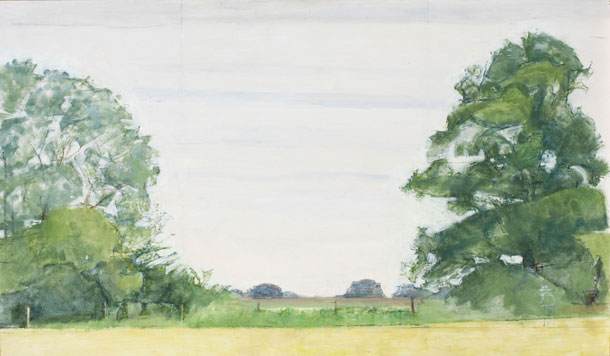
Patrick George, “U”, 2003 oil on board 23.5 x 40 in
The Slade School of Art Part IV – Patrick George Interview
“I try to paint a likeness of what I see … In London I paint pictures of people, of things lying around my room and the view out of the window. In the country I go outside and paint the landscape … The pictures take a long time to paint, sometimes several years.”
As far as big names at the Slade School of Art, Patrick George is one of the most under recognized. His work is sensitive and subtle and was for me the great reward of looking for artists in the UK. The art critic Andrew Lamberth quotes Sarah Kent in his catalog for the show A Critic’s Choice “These are not anxious paintings – the artist does not fiddle or worry at his work. They are relaxed, calm and tender rather than obsessive. “ He is considered by those who know his work to be one of the most important painters in the UK of last 50 years. Despite the fact that he is held in such high regard, it is very difficult to see his work or even to find much information on him. I think that, similar to Uglow, Patrick George sees the work as much more important than the promoting it. To illustrate this point when I requested an interview with him, he replied “I am glad you liked my pictures at Browse & Darby. That really is the point rather than answering questions.”
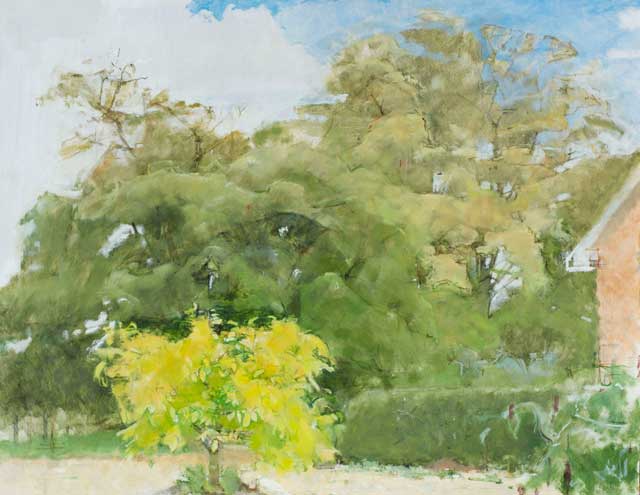
Walnut Tree 23 x 29 inches
(most of the images shown here are oil on board) also note that higher resolution image views can be seen by clicking image.
Patrick George has had a long standing relationship with Browse and Darby and also recently had a show at Cobbold and Judd. He was born on July 23, 1923 in Manchester, England. While a student in prep school, he was taught by Maurice Feild. According to Mr. George, this factored greatly in his artistic development. Feild was closely linked with the Euston School (where William Coldstream taught before teaching at the Slade School of Art) and eventually went on to teach at the Slade as well. After prep school, George went on to study at Edinburgh College of Art (1943-1943). George served during the war and after the war studied under Coldstream at Camberwell School of Art (1946-1949). His teaching started at the Slade School of Art in 1949 and continued for nearly 40 years retiring in 1988 from the position of director. George was a part of creating the Coldstream reports I and II.
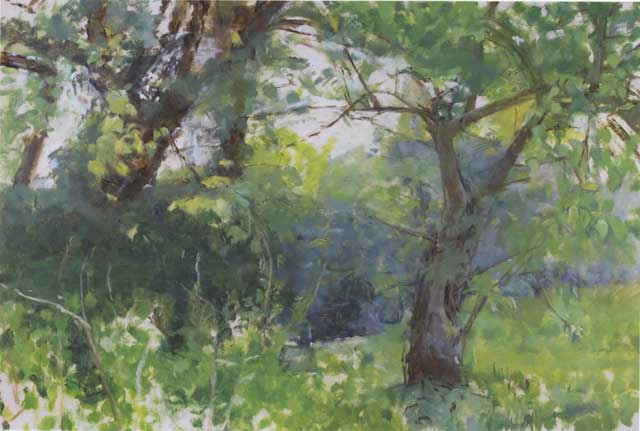
Greengage trees II 22 x 32 inches 2009
IMr. George very graciously agreed to answer a few questions about himself and his work.
Neil Plotkin Can you help us understand your life and career a little and talk about what were the turning points in your career.
Patrick George
I remember the most important one now. At my Prep school, a rather advanced Prep School, we had hobbies days and I joined the painting hobby. Maurice Field was the teacher in charge, he had just left the Slade, this was in the ‘30s. We all painted on cardboard boards with oil paint and used petrol as a medium. I was born in Manchester, an industrial part of England, so I painted the industry; smoking chimneys – light railways – pit head gear and grey cloudy skies. I was not one of the Art set. We were taught English by W.H.Auden and all wrote poetry. In the school Art class we learnt about Le Corbusier, the Impressionists, Cezanne, Van Gogh and Duchamp and I remember a Dada exhibition set up by the boys. I liked the reproductions on the walls but although Cezanne was the fashion, Matisse and Picasso were obviously ‘it’. I liked drawing what I could see but realised that for me Picasso was impossible, in fact I was frightened by Picasso.
A little later, perhaps 1936, William Coldstream was invited to come from London and paint [by] W.H.Auden, whom he knew from London. Now William Coldstream was an artist of repute, an artist who painted portraits and industrial landscapes and St Pancras station and the trains. These were my subjects, likenesses of people and places. At home all Art was judged on whether it was like, or not, Aunts, my sisters, dogs, my parents. So I realised that real Artists could do likenesses and that was it. I could be an Artist after all!
Then came the War and my parents thought I would get over being a painter, but when I survived the War I was not going to listen to any advice so I went to Camberwell, because Coldstream was teaching there.
NP Considering that you studied under one of the great mid 20th century teachers (William Coldstream) and you yourself went on to be extremely influential to several generations of painters, how do you see to the legacy of your teaching and the legacy of your painting? What artists do you feel like carry on the spirit of William Coldstream and the spirit of your work?
PG I have no idea and suspect that no artists are carrying on the legacy of my teaching. The spirit of William Coldstream was one of literalism
NP You and Euan Uglow both studied at the Camberwell School of art with William Coldstream. Initially, it seems that your work was influenced by your mentor but over time both you and Euan Uglow evolved in very different manners. Did you influence each other or consciously work to get away from William Coldstream or did you consciously try to stay true to the teaching of William Coldstream?
PG Uglow and I were no doubt influenced by Coldstream and a great many other artists both living and dead – Uglow by Mantegna and the other Northern Italian artists and myself by Durer and Rubens. It never occurred to us to stay true to the teaching of Coldstream, but because we were friends we obviously influenced each other.
NP As a person who has consistently worked from life over a long period of time, you have seen painting come in and out of favor (and perhaps back in again). how do you see representational painting surviving and remaining vital to the discourse of image making and to the public as a whole? And as an esteemed artist deeply enmeshed in the UK traditions of representational painting, how do you see that tradition evolving?
PG Representational painting in England is not going to stop suddenly now; it changes like clothes change depending on the fashion of the time.
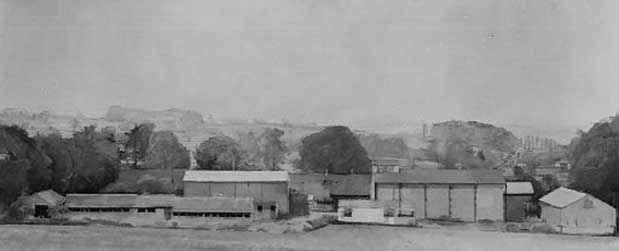
Hickbush the Grove, 20 x 50 inches 1975-1976
NP Based upon the letters about the painting of Hickbush the Grove, I understand that in your earlier paintings, your painting process could go through over 100 sessions in the effort to create one painting. The work that was in your more recent shows gives a sense of a different process – quicker and more open ended. How has your process of painting evolved over time and why?
PG As I view my painting I am amazed how it has stayed so much the same.
NP With your current work, it seems as if you are drawing the paintings in thin washes of color. What role does drawing play in your studio practice? Related to this, these paintings also seem to have qualities of watercolor paintings (in the thin layers of color and the sense that you are drawing in colors). If you find that relevant to your work, could you talk about watercolor painting and its’ relationship to your working process?
PG At the moment the paint, I notice, is a little thicker. Thin paint, paint thinned with turpentine, is easier to change and there is always the belief in the beauty of the white ground.
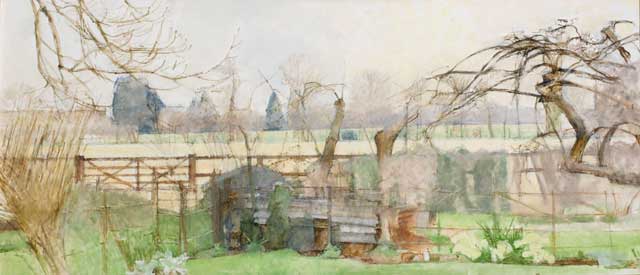
Apple Tree and Gate 24 x 55 inches 2002-2003
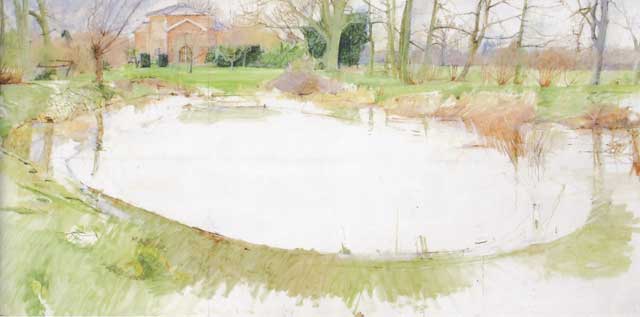
The Pond and Grandfather’s 30 x 60 inches 2006-2007
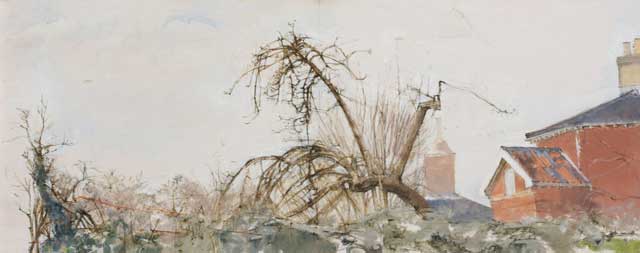
House to the Right 19 x 48 inches 2004-200
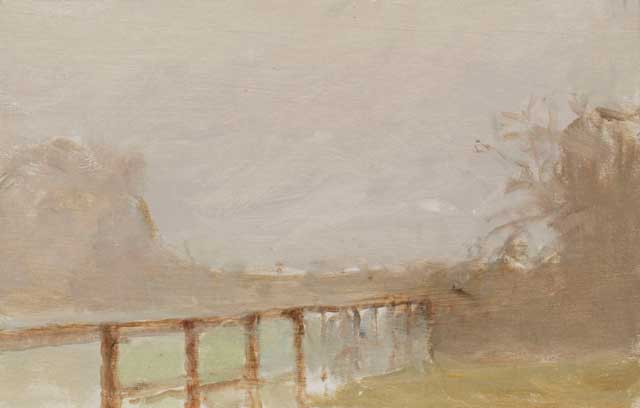
Fog, Gap and Fence 5 x 8 inches 2005
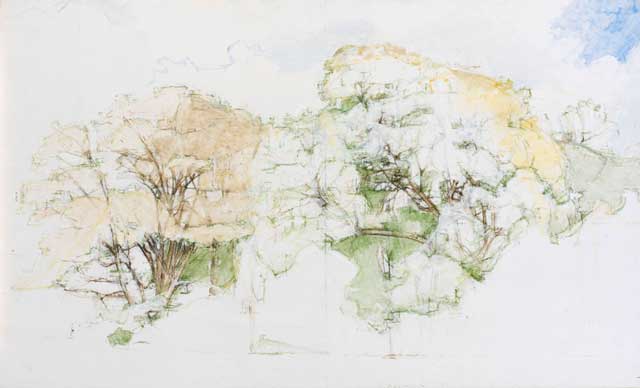
Ash Tree and Sycamore 36 x 59 inches 2003-2004
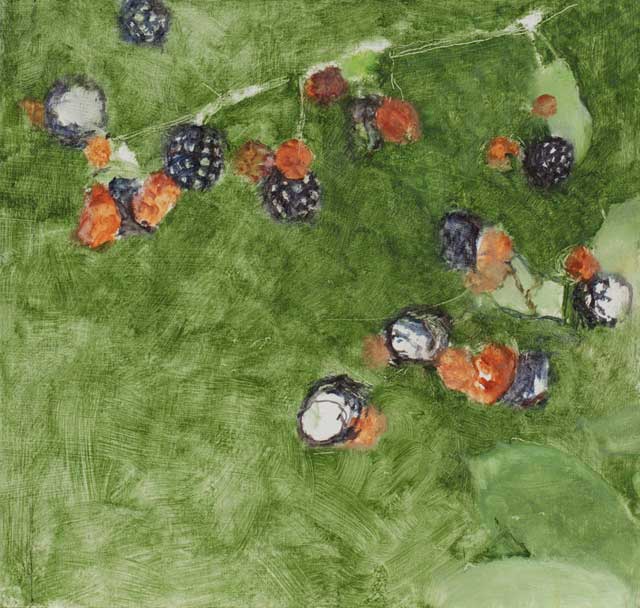
Blackberries 8 x 8.5 inches 2003
Final Note:
As with the Euan Uglow article, I want to make it clear that this article is only meant to be my personal interpretations of Patrick George and his work. As stated there is so little information available, and I would love to hear from some of his students or colleagues with any sort of information. If there are any inaccuracies or omissions please contact me directly at Neilplotkin@yahoo.com

Links: There is very little on the web about Mr. George and these are the best I could find. He comes up in the obituaries of many great artists and people in the art world so it seems Mr. George has been very well acquainted with many great artists of the UK.
The best place to see a lot of images (and I would suggest buying catalogs if there are any available) is Browse and Darby’s page on Patrick George
Letters about the painting of Hickbush the Grove.
Paintings in government collections:
http://www.gac.culture.gov.uk/search/Artist.asp?maker_id=124364
This is a really interesting article from the New York Times in 1981 about a show at Yale. It’s a 30 year time capsule about many of the artists in Slade group
http://www.nytimes.com/1981/11/29/nyregion/art-figurative-painters-in-yale-show.html






Thank you Neil for the insightful article.
Here is a link to a wonderful portrait recently sold at Christie’s at a bargain price. It was bought by a painter, I am terribly envious !
http://www.christies.com/LotFinder/lot_details.aspx?intObjectID=5285853
Seems like a very subtle and sensitive artist. I love the painting “House to the Right”; it’s like the branch in the middle just grew out of the canvas. “Hickbush the Grove” looks like a stunning painting, too. I’m sure he enjoys being a reclusive guy…just leave me alone and let me paint my farmhouse kind of attitude. I can’t believe that painting (from the link above) sold at Christies for only $2600! What a great deal for a fabulous painting.
The portrait on Christie’s website is beautiful (thank you Ilaria for sharing the link) but what a shame to have sold for so little and the guide price was sooo low. A Uglow would have sold for tens of thousands although neither did much to promote himself.
Ilarea – thank you for the link (I had actually found that link as well and had to make a hard decision. I wanted to include it to show some older work but didn’t to hurt Mr. George’s current prices but now there is a very lucky artist with a great painting!). There are now some other pictures up at other auction sites but without prices (seems a few went up for auction recently):
http://www.artnet.com/artist/592806/patrick-george.html
http://www.arcadja.com/auctions/en/george_patrick/artist/174747/
I also found your painting to be really a wonderful at the BP Portrait show in London. It was one of my favorites in the show.
Thank you Neil. I didn’t think about the damaging side, anyway his gallery prices are much higher, clearly this painting has slipped through the net.
hi neil i was wondering if you had seen this painting on ebay ? according to the description the artist is well known and from the uk and i wondered if anybody had seen her work before and can give any information other than what is described.
Dear Neil,
I had Patrick, as a life painting instructor at the Slade in 81′ He was fussy about everyone painting what they see and staying loose, no committing to form or color too soon, I remember one day in a crit a girl painting a nude from life at the Slade had colored he background in shades of purple??
Patrick asked what she was thinking ?? purple ? ” She said she noticed a purple color in the background ?? What?… he says .. ” If I cut out a pic of that wall, and took the sample to the paint ( hardware type ) store and asked them to mix the color exact, what color do you think they would give me in the tin ? Purple? she said ? Its was funny , He didn’t want anyone using that much artistic license, at least till they mastered basics. he taught me to trust your eye and that nature is abstract enough .
As far as why his works are not climbing too high in value I can only guess people haven’t taken the time to really look at them, Those with the means to buy such works have too many choices, and likely don’t know what they want.
Wow Scott I feel like your talking about me! Except I had Patrick George in a figure study class in 1979 – he basically said the same thing. I was applying some alizarin to build up a color for a chair (us girls love our purps!) and was promptly scolded for it. He asked me ‘where did I see that color?’ I was a little embarrassed but have been grateful ever since. I think he also said something about there being enough in nature – i remember him speaking about the complxity of painting a wall! It was only a summer study but he was probably the most influencial teacher ive ever had. Truly a great painter – I hope to hear and see more from him.
Thank you Neil for this and all the rest of the Slade School Artist series – I’m getting to this waaaay late (I juststumbled upon the PP website)
Scott,
Thank you so much for that story! That is incredibly funny and I think his approach to teaching is really a great lesson to remember as we start out our paintings. don’t get lost in the specifics and focus on the bigger elements. The specifics come in time. Were you able to see any of his work as a student? thanks again for that story!
sorry jerry your request wasn’t posted until yesterday but i don’t think that this would be the right place to find out about artists that you want to buy on ebay. i think you would probably have better luck just googling them as this blog covers artists that fall into the moderator’s concept of perceptual painters and I am by no means an expert on English painters. best of luck
Neil and Gerry,
My apologies for the delay in posting Gerry’s recent comment. It fell through the cracks somehow. I have a spam filter set up so first time posted have to be checked by me for spam and I must have missed this comment previously.
What a rich seam of Patrick George’s more recent work – previously unfamiliar to me. I saw his retrospective at the Serpentine Gallery in 1980, and that left a deep impression. I think he is a very underrated and extraordinarily sensitive painter of the observable world. Some of my generation [now early 50’s] were trained a little in the Euston road tradition, and it left quite a mark on some who went through it. The main thing that strikes me about this type of painting is its durability/staying power – it seems to improve with repeated viewings. Most other ‘styles’ suffer a little in that regard. I’ve read a lot about the artists involved and have tried – rather unsuccessfully to adopt the working methods. I haven’t a clue as to whether the practice continues in art schools to this day, I hope it does somewhere.
I have only just discovered this fabulous website while searching for information about Patrick George’s teaching and painting philosophies. I went to art school in the mid seventies when conceptual art was taking hold. At least we still had a life room but landscape painting was considered to be passé, however I have continued to paint landscapes to the present day and would give anything to turn the clock back and receive a few hours tuition from Patrick George!
Are there anymore ex students out there with experiences to tell?
Dear Sir,
I am a professional picture framer based in Bury St Edmunds.
For several years now I have framed probably over eighty, normally large scale oils, for Patrick’s exhibitions at the Browse, Darby Gallery in London as well as other venues and clients. They present a challenge because they are painted on thin plywood which can snap if not careful.
We always have a chat when he comes in to my gallery but I know he is not well at the moment so I wish him well and look forward to the next framing project from him.